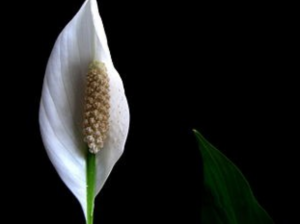Happy New Year from Belle Fiori! We’re so excited to begin another year of business in the Milwaukee area. Providing floral arrangements for all your weddings, parties, and other special events is truly a privilege for us, and we look forward to serving you in 2013! Make sure to stop in and visit us this year if you haven’t taken a look inside our shop. Also, check out an article on Belle Fiori’s January Plant of the Month, the Peace Lily!

A long-time favorite of plant store owners and growers, the Peace Lily (or Spathiphyllum) finally got the recognition it deserves from the general public after NASA put it on its list of “Top Ten Household Air Cleaning Plants.” This tropical plant breaks down and neutralizes toxic gases like formaldehyde and carbon monoxide inside its pores. While we all appreciate cleaner, oxygenated air, it’s also the easy Peace Lily care, resiliency and forgiving nature that makes them such popular house plants. One of the great advantages in caring for the Peace Lily is the fact that it sags a bit when it needs water.
The basic Peace Lily Care tips below are followed by pruning, propagating and problem-solving this widely available plant. Since you can create one or two new plants yearly from an initial Peace Lily plant, it’s cost-effective to provide the plant’s minimum requirements.
Placement: Since east windows allow direct sun rays and south windows allow indirect, but all day, light in consider putting the plant in a room that’s north or west facing instead. This is not to say the plant should be right on a window sill. Keeping the Peace Lily six to eight feet away from a window helps keep light levels consistent as well.
Light: Prefers medium, indirect sunlight. Yellow leaves indicate the Peace Lily is getting too much light. Brown spot and streaks indicate direct sun rays have reached the plant and scorched it. Peace Lilies do fine under florescent lights and some have been known to thrive in rooms with no windows at all!
Temperature: The Peace Lily makes a great house plant because it thrives in the indoor temperatures people enjoy. A temperature range of 65°F to 80°F keep the plant happy. As cold drafts will harm it, make sure to keep it away from non-insulated windows and screen doors. Beware. Because temperatures below 45°F will kill it, so keep it indoors much of the year.
Fertilizer: While not every grower fertilizes the Peace Lily, those who want the best blooms make sure they fertilize during the spring and summer growing season. Feed a general house plant fertilizer (20-20-20) at one-half or one-quarter recommended strength once per month spring through summer.
Water: Many growers wait for the plant to droop slightly before watering, allowing the plant to tell them when it’s thirsty. In general, water at least once a week and spritz the leaves with soft or distilled water throughout the summer growing season. Water plant less in winter.
If you find your plant completely depleted with fronds flat over pot edge because you forgot to water for a while, don’t just throw it in the trash. Water and spritz right away. You may be surprised at how quickly the Peace Lily revives.
If your municipal water system is heavily chlorinated, fill a container with water and then allow it to stand overnight so the chlorine can percolate out before pouring into the Peace Lily. Peace lilies can be sensitive to chlorine.
Growth: The standard Peace Lily can grow to 24-40 inches and deluxe plants can grow to 32-50 inches.
Blooming: The white blooms of the Peace Lily generally appear in the spring as more of a modified leaf, a “bract,” than a multi-petaled flower. Very well cared for plants may bloom again in the fall as well. Blooms last for two months or more. After blooms fade, a period of non-blooming follows.
Re-potting the Peace Lily: Re-pot the Peace Lily when roots are apparent or when it seems to be taking up all water provided every few days. See re-potting section below.
Are Peace Lilies Poisonous to Cats, Dogs and Kids?
From the Spathiphyllum family, Peace Lilies aren’t true lilies (Liliaceae) and so don’t pack the toxic punch genuine lilies do. This “lily” is really a “rhizomatous herb” from the forests of South America, more closely related to the Anthurium.
Even so, Peace Lilies do contain oxalates which can irritate an animal’s mouth and stomach. Because the irritation begins at first bite, however, the animal stops eating the plant pretty quickly, avoiding severe poisoning. Cats and dogs that ingest Peace Lily leaves begin to salivate profusely, shake their heads and paw at their mouths.
The Easter Lily, on the other hand, can kill an animal within a day. Any cat or dog caught eating an Easter Lily needs to be taken to the vet immediately so as much of the poison can be removed from the digestive track before it is absorbed.
If, while repotting or moving the Peace Lily, irritated spots develop on your hands, simply wash with soap and water. Oxalates can irritate skin as well.
